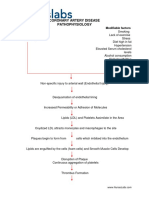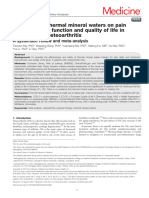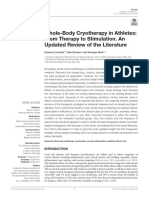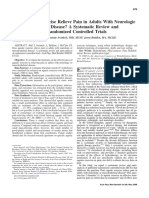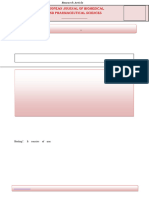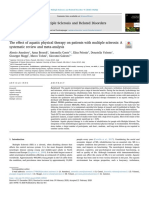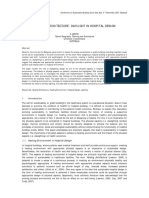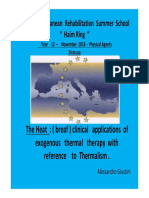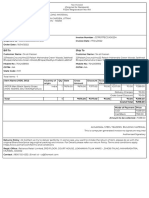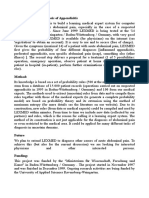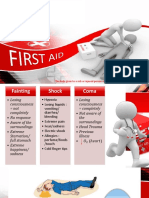New Evidence On Mechanisms of Action of Spa Therapy in Rheumatic Diseases
New Evidence On Mechanisms of Action of Spa Therapy in Rheumatic Diseases
Uploaded by
SkAliHassanCopyright:
Available Formats
New Evidence On Mechanisms of Action of Spa Therapy in Rheumatic Diseases
New Evidence On Mechanisms of Action of Spa Therapy in Rheumatic Diseases
Uploaded by
SkAliHassanOriginal Title
Copyright
Available Formats
Share this document
Did you find this document useful?
Is this content inappropriate?
Copyright:
Available Formats
New Evidence On Mechanisms of Action of Spa Therapy in Rheumatic Diseases
New Evidence On Mechanisms of Action of Spa Therapy in Rheumatic Diseases
Uploaded by
SkAliHassanCopyright:
Available Formats
Review
New evidence on mechanisms of action of spa therapy in rheumatic diseases
Sara Tenti, Antonella Fioravanti*, Giacomo Maria Guidelli, Nicola Antonio Pascarelli, Sara Cheleschi
Rheumatology Unit, Department of Medicine, Surgery and Neuroscience, University of Siena, Italy
ABSTRACT
Spa represents a treatment widely used in many rheumatic diseases (RD). The mechanisms by which
immersion in mineral or thermal water ameliorates RD are not fully understood. The net benefit is
probably the result of a combination of factors, among which the mechanical, thermal and chemical
effects are most prominent. Buoyancy, immersion, resistance and temperature play important roles.
According to the gate theory, pain relief may be due to the pressure and temperature of the water on skin;
heat may reduce muscle spasm and increase the pain threshold. Mud-bath therapy increases plasma β-
endorphin levels and secretion of corticotrophin, cortisol, growth hormone and prolactin. It has recently
been demonstrated that thermal mud-bath therapy induces a reduction in circulating levels of
prostaglandin E2, leukotriene B4, interleukin-1β and tumour necrosis factor-α, important mediators of
inflammation and pain. Furthermore, balneotherapy has been found to cause an increase in insulin-like
growth factor-1, which stimulates cartilage metabolism, and transforming growth factor-β. Beneficial
anti-inflammatory and anti-degenerative effects of mineral water were confirmed in chondrocytes cultures,
too. Various studies in vitro and in humans have highlighted the positive action of mud-packs and thermal
baths, especially sulphurous ones, on the oxidant/antioxidant system. Overall, thermal stress has an
immunosuppressive effect. Many other non-specific factors may also contribute to the beneficial effects
observed after spa therapy in some RD, including effects on cardiovascular risk factors (e.g. adipokines)
and changes in the environment, pleasant surroundings and the absence of work duties.
Keywords spa therapy, balneotherapy, rheumatic diseases, mechanisms of action
INTRODUCTION Nowadays it represents an useful alternative to the
pharmacological therapy, because of problems related to the
Recent treatment regimens of some chronic rheumatic diseases use of drugs that often have significant side effects and the
(RD) comprise multimodal concepts including pharmacologic, occasional lack of valid therapeutic strategies (Bresalier et al.,
physical/exercise, occupational and psychological therapies to 2005; Kearney et al., 2006; Ofman et al., 2002; Zhang et al.,
support the long-term management of disease. Spa therapy is 2004). The efficacy of spa treatments in RD has been bolstered
widely used for musculoskeletal system disorders, such as low by ancient tradition, but in spite of their long history and
back pain, Fibromyalgia or Osteoarthritis (OA) (Annegret and popularity, only a few randomized, controlled trials (RCTs) on
Thomas, 2013). Thermal therapy is very popular in many the use of these therapies in patients with RD have been
European and Middle Eastern countries, as well as in Japan and conducted and this topic is still the subject of debate and its
Israel. This treatment comprises a broad spectrum of role in modern medicine continues to be unclear (Verhagen et
therapeutic modalities including hydrotherapy, balneotherapy, al., 2007). Existing clinical researches are not sufficiently
physiotherapy, mud-pack therapy and exercise. The terms strong to draw firm conclusions; additional large and well-
hydrotherapy and balneotherapy were accepted for all forms of designed RCTs are needed to confirm preliminary evidences.
treatment with water. Balneotherapy uses natural thermal The aim of spa therapy is to reduce pain, relieve muscle
mineral waters, whose definition is based on the sum of the spasms and improve muscle strength and functional mobility
cations Na, K and Mg and the anions SO4, Cl and HCO3; the (Bender et al., 2005; Sukenik et al., 1999). The action
water is generally used at a temperature of around 34 degrees mechanisms of mud packs and thermal baths are not
Celsius. Mud-pack is defined as a natural product that consists completely known, and it is difficult to distinguish the effects
of a mixture of mineral or mineral-medicine water with organic of thermal applications from the benefits that could be derived
or inorganic material produced from biological and/or from a stay in a spa environment (Sukenik et al., 1999).
geological processes and used as a therapeutic treatment in the Although the results of the existing studies are not strong
form of a mud wrap applied locally or to the whole body enough to draw firm conclusions, it is necessary to ask what
(Bender et al., 2005; Nicholas, 1999; Sukenik et al., 1999). real medical and scientific value these therapies have. The
*
objective of this review is to summarize the currently available
Correspondence: Antonella Fioravanti information on mechanisms of action and possible effects of
E-mail: fioravanti7@virgilio.it spa therapy in RD. We also provide some suggestions for
Received October 23, 2013; Accepted February 18, 2014; Published
February 28, 2014
further development in this area.
doi: http://dx.doi.org/10.5667/tang.2013.0029
© 2014 by Association of Humanitas Medicine Mechanisms of action of spa therapy in RD
This is an open access article under the CC BY-NC license. The mechanisms by which immersion in thermal mineral water
(http://creativecommons.org/licenses/by-nc/3.0/)
TANG / www.e-tang.org 2014 / Volume 4 / Issue 1 / e3
1
Spa therapy and rheumatic diseases
alleviates suffering in RD are not fully understood. The net of collagen-rich tissues, such as tendons, fasciae and articular
benefit is probably the result of a combination of factors, capsules, which may improve the range of motion of joints
among which the mechanical, thermal and chemical effects are (Sukenik et al., 1999).
most prominent (Sukenik et al., 1999). The effects described make it possible to break the vicious
A distinction can be made between the non-specific circle of pain-muscle contraction-altered joint dynamics-pain
(hydrotherapeutic in a broad sense) mechanisms common to that characterizes many chronic arthropathies. The reduction of
simple baths in hot tap water, and specific (hydromineral and muscle tone and better use of joints represent just two of the
crenotherapeutic) mechanisms, which depend on the chemical most important elements that show the medium and long-term
and physical properties of the water used. While the former are beneficial effects documented in various clinical studies
well known, the latter are difficult to identify and assess (Cantarini et al., 2007; Elkayam et al., 2000; Fioravanti et al.,
(Sukenik et al., 1999). 2007; Fioravanti et al., 2010; Forestier et al., 2009; Guillemin
et al., 1994; Harzy et al., 2009; Nguyen et al., 1997; van
Mechanical, thermal and chemical effects Tubergen et al., 2001).
Spa therapy may have beneficial effects on muscle tone, joint The chemical effects of mud-packs and thermal therapy are
mobility, and pain intensity. less clear than the physical effects. In theory, it cannot be
Increased buoyancy and hydrostatic pressure during excluded that the organic substances or minerals of water or
immersion in thermal mineral water cause many physiologic mud, sometimes present in traces, can be absorbed through the
changes. Immersion to the suprasternal notch in mineral water skin and then act at a systemic level. However, experimental
(35°C) results in a cascade of reactions including increased evidence available in this field is scarce. Shani et al. (1985)
diuresis, natriuresis, and cardiac output (Epstein, 1992; O’Hare documented a significant increase in serum concentrations of
et al., 1985; Weston et al., 1987). The basis of these bromine, rubidium, calcium and zinc in patients with psoriatic
physiological effects is considered to be the hydrostatic arthritis who bathed in the Dead Sea. The penetration of the
pressure, which forces approximately 700 ml from the lower solutes is presumably influenced by the length of bathing time,
extremities to the central compartment. Distension of the the temperature of the thermal water, its composition and other
volume receptors by this central hypervolemia is regarded as factors, some of which may still be unknown. Furthermore, it
the trigger for the observed physiological effects (Epstein, 1992; has been reported that the direct application of mud-pack has
O’Hare et al., 1985; Weston et al., 1987). greater clinical effects than the application of nylon covered
The effects of thermal baths are partially related to mud pack in patients with knee OA (Odabasi et al., 2008).
temperature. Hot stimuli may influence muscle tone and pain
intensity, helping to reduce muscle spasm and to increase the Immunologic aspects
pain threshold in nerve endings. According to the “gate theory”, Since sulphur baths have been successfully used in various skin
pain relief may be due to the temperature and hydrostatic immunomediated afflictions, it has been suggested that
pressure of water on the skin (Melzack and Wall, 1965). absorption through the skin of trace elements present in mineral
Thermal stress provokes a series of neuroendocrine water and mud packs may affect the immune system (Sukenik
reactions. In particular, the heat stimulates the release of et al., 1997).
adrenocorticotropic hormone (ACTH), cortisol, prolactin and Overall, thermal stress has an immunosuppressive effect.
growth hormone (GH), although it does not alter the circadian With regard to hyperthermia a stimulatory effect of the immune
rhythm of these hormones (Kuczera and Kokot, 1996). response appear to prevail at a moderate increase of local skin
The effect of thermal stress on the hypothalamus-pituitary- temperature, with increase of pro-inflammatory cytokines
adrenal axis seems to be particularly important for the interleukin (IL)-6 (Sobieska et al., 1993) and IL-1β (Olszewski
antiedemigenous and anti-inflammatory actions of et al., 1989), whereas higher temperatures (40 - 41°C)
corticosteroids, as well as for the frequent alteration of the axis apparently suppress immune functions (Lange et al., 2006;
during some RD (Gur et al., 2004). The increase in beta- Schmidt and Simon, 2001).
endorphin demonstrated to occur with various spa therapy A significant reduction in circulating levels of T-
techniques has an analgesic and anti-spastic effect that is lymphocytes has been demonstrated in healthy volunteers
particularly important in patients for whom pain is the treated with hyperthermal baths (Sukenik et al., 1999) and in
prevalent symptom (Cozzi et al., 1995; Kubota et al., 1992). patients with respiratory and cutaneous atopy (Valitutti et al.,
Recent data have demonstrated the possibility that normal 1990). Hyperthermia-induced T-lymphocytopenia and eosino
keratinocytes can produce and secrete a precursor pro- penia may be due to a redistribution of the cells, probably due
opiomelanocortin (POMC) following various stimuli (e.g. to the increase of ACTH and cortisol provoked by thermal
ultraviolet rays, thermal stimuli) which is the common stress (Kuczera and Kokot, 1996).
precursor of various endorphins (Ghersetich et al., 2000). This In vitro studies have demonstrated that sulphurous waters
finding allows us to formulate the fascinating hypothesis that have a dose-dependent inhibitory effect on the blast
ultraviolet radiation or thermal stimuli could be used to transformation and proliferation of T lymphocytes obtained
condition the skin’s production of opioid peptides, thus altering from peripheral blood in both healthy subjects and subjects
the personal emotional sphere or pain threshold. If we add that affected by chronic inflammatory diseases (Valitutti et al.,
ß-endorphin also has immunomodulatory effects, the 1990). On the other hand, immersion in thermal waters at a
hypothesis of a close correlation between spa therapy and the temperature of 40°C reduces the lymphocyte response to
psychoneuroendocrine system becomes increasingly phytohaemoagglutinin (Smith et al., 1978). Sulphurous waters
convincing (Berczi et al., 1996). also seem to exert a potent inhibitory action on the production
Furthermore, hyperthermia plays an important role on of cytokines, especially IL-2 and interferon gamma (IFN-γ). As
immune system function (see below). these cytokines are mainly produced by CD4+ lymphocytes, it
Hyperthermia also has many effects on granulocytes. Heat can be hypothesized that memory T cells are the principal
increases their mobility, phagocytic and bactericidal properties target of sulphur-rich waters. The application of sulphurous
and enzymatic activity (Sukenik et al., 1999). waters reduces the capacity of memory T cells to proliferate
Furthermore, thermal stimulation increases the extensibility and produce cytokines, thus resulting in an alteration of
TANG / www.e-tang.org 2014 / Volume 4 / Issue 1 / e3
2
Spa therapy and rheumatic diseases
immune response (Ghersetic and Lotti, 1996). The
hyperthermia-induced alterations of the cytokine milieu has
been recently confirmed in patients affected by ankylosing
spondylitis (AS) (Tarner et al., 2009). Tarner et al. (2009)
showed that the serum levels of tumor necrosis factor (TNF)-α,
IL-1β and IL-6 which were measured before, during and after
whole-body hyperthermia, were significantly reduced in
patients with AS whereas the changes in healthy subjects did
not reach statistical significance.
Anti-inflammatory and chondroprotective aspects
Recent studies have shown a reduction of circulating levels of
Prostaglandin E2 (PGE2) and Leukotriene B4 (LTB4),
important mediators of inflammation and pain, in patients
suffering from OA or fibromyalgia who undergo mud-packs or
balneotherapy (Ardiç et al., 2007; Bellometti and Galzigna,
1998) (Table 1).
Crenotherapy also affects the synthesis of various cytokines Fig. 1. Serum Leptin and Andiponectin levels in 30 knee OA patients
involved in the ongoing chondrolysis and inflammation in RD; treated with spa therapy, evaluate at baseline (T0) and after 2 weeks
in fact a reduction in the cytokines IL-1β and TNF-α and the (T1) through ELISA assay (from Fioravanti et al., 2011). *p < 0.05 vs
Basal time
soluble receptors of the latter has been demonstrated following
a cycle of mud-baths therapy (temperature > 41C°) in patients myristate-13-acetate (Braga et al., 2008). Various studies in
with OA (Bellometti et al., 1997; Bellometti et al., 2002; humans have highlighted the positive action of mud-packs and
Cecchettin et al., 1995) (Table 1). thermal baths, especially sulphurous ones, on the
Several studies have provided evidence for a significant oxidant/antioxidant system. Grabski et al. (2004) reported the
role of matrix metalloproteinases (MMPs), particularly MMP-3 reduction of superoxide dismutase (SOD) activity in patients
or stromelysin-1, produced by activated chondrocytes and other with rheumatoid arthritis undergoing treatment with sulphuric
cell types in the development of cartilage degradation in joint water. Eckmekcioglu et al. (2002) demonstrated that 3 weeks of
diseases (Lohmander et al., 1993). A recent study of Bellometti sulphur baths can reduce the antioxidative defence system
et al. shown that MMP-3 serum levels were significantly (SOD and glutathione (GSH) peroxidase) in the blood of
reduced by mud-bath therapy in patient with OA (Bellometti et patients with OA. They discussed that the decline of these
al., 2005). enzyme- activities may be caused by two reasons: either as
Cycles of mud applications and balneotherapy also bring consequence of reduced oxidative stress during sulphur therapy
about an increase in some growth factors, such as Insulin-like leading to a lower expression of these enzymes or as an
Growth Factor 1 (IGF1) (Bellometti et al., 1997), which enhanced generation of superoxide radicals exhausting the
stimulates cartilage anabolism (Trippel, 1995). Furthermore, a superoxide scavenging enzyme.
significant increase in circulating levels of Transforming Bender et al. demonstrated that therapeutic baths in mineral
Growth Factor-beta (TGF-β) has been found in patients with water reduced the activity of catalase, SOD, malondialdehyde
AS after a combined spa-exercise therapy (exercise, and GSH peroxidise (Bender et al., 2007). Other authors have
hyperthermia and exposure to low doses of radon) (Shehata et observed a significant decrease in NO and myeloperoxidase
al., 2006) (Table 1). TGF-β is a very potent immunomodulating and a slight increase in GSH peroxidase in the sera of subjects
and anti-inflammatory cytokine which plays a major role in with OA undergoing cycles of mud applications and
tissue healing, bone remodelling and fibrosis (Shehata et al., balneotherapy (Bellometti et al., 2000).
2006). In a recent study we assessed the possible modifications of
Among the various factors responsible for inflammatory plasma levels of leptin and adiponectin in patients with OA
and degenerative phenomena in joint during different RD, treated with a cycle of mud-bath therapy (Fioravanti et al,
reactive oxygen species (ROS) and nitric oxide (NO) should be 2011). Our data showed at the end of the therapy, a slight but
taken into consideration (Farrell et al., 1992). not significant increase of plasma leptin concentrations and a
Sulphurous waters have been demonstrated to have an significant decrease in serum adiponectin levels (Fig. 1). These
antioxidant effect in vitro; in fact the incubation in sulphurous adipocytokines play an important role in the pathophysiology
mineral water significantly reduces the release of ROS and the of OA (Lago et al., 2008). In particular, there is some evidence
reactive nitrogen species (RNS) peroxynitrite by that adiponectin in skeletal joints may have proinflammatory
polymorphonucleate leukocytes (PMNs) stimulated with N- effects and may be involved in cartilage degradation (Gomez et
formyl-methionyl-leucyl-phenylalanine and phorbol-12- al., 2009). In view of these recent findings, the decrease of
Table 1. Effect of thermal mineral baths on various mediators or factor of inflammation, immune response, and chondrolysis
1 Reduction of circulating levels of PGE2 and LTB4 (Lago et al., 2008; Lange et al., 2006)
Reduction of TNF-α, IL-6, IL-1β circulating levels (Kuczera et al., 1996; Leibetseder et al., 2004; Lohmander et al., 1993; Melzack et
2
al., 1965)
3 Increase of circulating levels of IGF1 (Odabasi et al., 2008)
4 Increase in circulating levels of TGF-β (exercise, hyperthermia and exposure to low doses of radon) (Ofman et al., 2002)
Reduction of the release of ROS and the RNS by PMNs stimulated with N-formyl-methionyl-leucyl-phenylalanine and phorbol-12-
5
myristate-13-acetate (Oláh et al., 2010)
6 Decrease in NO circulating levels (Shani et al., 1985)
PGE2 = prostaglandin E2; LTB4 = leukotriene B4; TNF-α = tumor necrosis factor-α; IL-6 = interleukin 6; IL-1β = interleukin-1β; IGF1 = Insulin-like
Growth Factor 1; TGF-ß = Transforming Growth Factor-beta; ROS = reactive oxygen species; RNS= reactive nitrogen species; PMNs = polymorpho-
nucleate leukocytes; NO = nitric oxide.
TANG / www.e-tang.org 2014 / Volume 4 / Issue 1 / e3
3
Spa therapy and rheumatic diseases
Fig. 2. Micrographs of cultured OA chondrocytes labeled with iNOS antibody. (A) DW-DMEM, controls; (B) Incubation with IL-1β (5 ng/ml); (C)
25% or 50% VW-DMEM; (D) 25% or 50% VW-DMEM with IL-1β; (E) 100% VW-DMEM; (F) 100% VW-DMEM with IL-1β. The cells show a
different immunolabelling pattern (arrows). Bar: 5 μm (from Fioravanti et al., 2013).
adiponectin after spa therapy demonstrated in our study may IL-1β. They analyzed the effects of different concentrations of
play a protective role in OA. a fast (NaHS) or a slow (GYY4137) release H2S donor on
Partial contradictory data were observed in a recent pilot three key aspects of the inflammatory process in OA. The
study conducted by Shimodozono et al. (2012). Authors Authors demonstrated a significant reduction of NO and
reported a significant increase of serum levels of leptin in 7 inducible Nitric Oxide Synthase (iNOS) gene expression, PGE-
healthy men after a single 10 min warm-water bath (WWB) at 2, and ROS levels induced by IL-1β in culture medium, after
41°C with tap water or WWB with inorganic salts and carbon incubation with H2S donors.
dioxide (ISCO2), and remained significantly higher than those A recent study by Fioravanti et al. (Fioravanti et al., 2013)
at baseline even 30 min after WWB with tap water; serum showed similar results in human OA chondrocytes cultivated
levels of adiponectin showed a slight, but not significant, with mineral Vetriolo’s thermal water (VW) in the presence or
increase immediately and 30 min after a single WWB under in the absence of IL-1β. OA chondrocytes were cultivated in
both conditions. These differences might be due to the Deionized Water (DW) (DW-DMEM, controls), or in one of
difference in subjects (relatively healthy, young, lean and male three different VW-DMEM media, in which DW had been
in this last study) and in modalities of bathing (duration of totally (100%) or in part (50% or 25%) substituted with VW.
thermal stimulation and the substances used in the mineral The results showed that VW alone at 25% or 50%
water). concentration did not affect the viability of cultured OA
Experimental studies in animal models of arthritis chondrocytes, and determined a significant survival recovery
corroborate the evidence of beneficial effects of mud-bath rate in cultures stimulated with IL-1β. On the contrary, the VW
therapy on inflammatory and degenerative joint diseases. Cozzi alone at 100% of concentration reduced, in a significant (p <
et al. (Cozzi et al., 2004) have recently demonstrated an anti- 0.05) manner, the cells viability. NO levels were low both in
inflammatory effect of mud–bath applications in Freund’s DW-DMEM cultures and in those reconstituted with 25% or 50%
adjuvant-induced arthritis in rats. In 2007 Britschka et al. (2007) of VW, and were significantly (p < 0.05) increased in cultures
confirmed the anti-inflammatory and chondroprotective effects with 100% of VW. VW at 25% or 50% concentration
of the application of mud in Zymosan-induced arthritis in rats, significantly (p < 0.001) reduced the NO production induced by
by performing histological analysis on synovial tissues and IL-1β. The data of the NO levels were confirmed by the
cartilage taken from the sacrificed animals on day 21 of immunocytochemistry assay for iNOS (Fig. 2). Furthermore,
treatment. the Authors confirmed the pro-apoptotic effect of IL-1β and
The possible chondroprotective role of mineral water or demonstrated a protective effect of VW at 25% or 50%
mineral components was confirmed by some pilot in vitro concentration. These findings were confirmed by transmission
studies in chondrocyte cultures. Burguera et al. (Burguera et al., electron microscope (TEM) assessment (Fig. 3).
2012), in 2012 studied the possible activity of hydrogen
sulphide (H2S) as an anti-inflammatory and anti-oxidant agent Other aspects
in human osteoarthritic articular chondrocytes stimulated with Many other non-specific factors may also contribute to the
TANG / www.e-tang.org 2014 / Volume 4 / Issue 1 / e3
4
Spa therapy and rheumatic diseases
Fig. 3. TEM micrographs of human OA chondrocytes: (A) DW-DMEM, controls: the cell shows a good state of health. (B) Incubation with IL-1β (5
ng/ml): Vacuolization (V) of the cytoplasm and reduction in quality of Golgi bodies, rough endoplasmic reticulum (RER) and mitochondria (M). (C)
25% or 50% VW-DMEM: not particular morphological alterations. (D) 100% VW-DMEM: Altered status of chromatin and of cytoplasm structure.
Normal plasma membrane and nucleus (N). (E) 25% or 50% VW-DMEM with IL-1β: The cell partially restores its morphology. Euchromatic nucleus
(N), restored organization of cytoplasm [vacuoles (V) very reduced, abundant rough endoplasmic reticulum (RER), well shaped mitochondria (M)].
Plasma membrane with cytoplasmic processes. (F) 100% VW-DMEM with IL-1β: Vacuoles (V), reduction of cytoplasmic organelles, and nucleus
(N). Bar = 1 μm (from Fioravanti et al., 2013).
beneficial effects observed after spa therapy in some RD, therapeutic option in hypertension and obesity and that it
including effects on cardiovascular risk factors. improved some metabolic and inflammatory markers, such as
The lipid normalizing effects of balneotherapy, especially hs-CRP on haemoglobin A1C levels.
with sulphurous waters, have been reported for decades. The The reduction of cardiovascular risk factors through mud-
results of such research have documented reductions in total packs and spa therapy is especially important considering the
cholesterol, triglycerides and nonesterified cholesterol and a clear and much-stressed association between various RD and
significant increase in HDL- cholesterol (Strauss-Blasche et al., atherosclerotic processes (Turesson et al., 2008).
2003). Finally, other elements need to be taken into consideration
More recently, attention has focused on plasma concerning the mechanisms of action of mud applications and
homocysteine, a risk factor for coronary heart disease, spa therapy in RD, such as the particular climatic and
congestive heart failure, systolic hypertension, environmental conditions of spas. One of the most important
artherothrombotic events, complications in diabetes mellitus, aspect of spa therapy is the psychologic effect of removal from
cancer and oxidative stress (Agullo-Ortuno et al., 2002; the stress of home and work. Those receiving spa therapy
Bostom and Selhub, 1999; Sun et al., 2002; Vasan et al., 2003). experienced not only reduced pain and improved function but
A significant reduction in plasma homocysteine has been also experienced greater physical and mental quality of life and
demonstrated in OA patients after a cycle of sulphurous thermal less anxiety and depression (Bender et al., 2005; Sukenik et al.,
baths (Leibetseder et al., 2004). 1999).
Recently Oláh et al. (Oláh et al., 2010) explored changes in
several cardiovascular risk factors in a group of patients
suffering from degenerative musculoskeletal disorders CONCLUSIONS
subjected to a cycle of balneotherapy. For the first one, the
Authors showed a statistically significant and lasting (3 months In this review we highlighted the effects of spa therapy and
after the cycle of balneotherapy) decrease in serum levels of mud applications on various mediators or factors of
high- sensitivity C-reactive protein (hs-CRP) in patients treated inflammation, immune response and chondrolysis. Although
with mineral thermal baths. the data presented are stimulating, it is impossible to ignore the
Always Oláh et al. (Oláh et al., 2011) in a consecutive existence of a complex series of problems and uncertainties that
study explored the changes of antioxidant, inflammatory and prevent spa therapies from gaining the full consensus of the
metabolic parameters in obese and hypertension people after scientific community (Verhagen et al., 2007). One of the
balneotherapy. This study showed that balneotherapy is a safe critical points is the controversial problem of the absorption of
TANG / www.e-tang.org 2014 / Volume 4 / Issue 1 / e3
5
Spa therapy and rheumatic diseases
the minerals dissolved in thermal waters, e.g. the demonstration glutathione peroxidase serum levels in arthritic patients. Int J
of specific effects other than those linked to the simple action Clin Pharmacol Res. 2000;20:69-80.
of heat. Unfortunately few studies have been conducted on this
topic and little is known about the specific effects of various Bellometti S, Galzigna L, Richelmi P, Gregotti C, Bertè F. Both
mineral waters. It is still not clear which elements are essential serum receptors of tumor necrosis factor are influenced by mud
and what is the ideal concentration of each element in order to pack treatment in osteoarthrotic patients. Int J Tissue React.
attain an optimal response to treatment. It remains to be 2002;24:57-64.
clarified which mineral waters are most suitable for various
diseases and whether the different components exert specific Bellometti S, Richelmi P, Tassoni T, Bertè F. Production of
actions. Such evidence would lead to a specialization of spa matrix metalloproteinases and their inhibitors in osteoarthritic
resorts, which could finally target their therapies more patients undergoing mud bath therapy. Int J Clin Pharmcol Res.
accurately and rationally. 2005;25:77-94.
Furthermore, the results reported only refer to short term
modifications of various mediators of inflammation, immune Bender T, Karagülle Z, Bàlint GP, Gutenbrunner C, Bálint PV,
response and chondrolysis, lasting until the end of the cycle, Sukenik S. Hydrotherapy, balneotherapy, and spa treatment in
and little is known of the possible long term effects. This is a pain management. Rheumatol Int. 2005;25:220-224.
key element in seeking to explain the persistence of the
symptomatic benefit induced by such therapies in some RD, as Bender T, Bariska J, Vàghy R, Gomez R, Imre Kovács. Effect
shown in long term controlled clinical trials (Cantarini et al., of balneotherapy on the antioxidant System – a controlled pilot
2007; Elkayam et al., 2000; Fioravanti et al., 2007; Fioravanti study. Arch Med Res. 2007;38:86-89.
et al., 2010; Forestier et al., 2009; Guillemin et al., 1994; Harzy
et al., 2009; Nguyen et al., 1997; van Tubergen et al., 2001). Berczi I, Chalmers IM, Nagy E, Warrington RJ. The immune
In conclusion, existing researches are stimulating, but are effects of neuropeptides. Baillieres Clin Rheumatol.
not sufficiently strong to draw firm conclusions. More studies 1996;10:227-257.
are needed to help draw firm conclusions regarding the
mechanisms of actions of spa therapy in various RD. Bostom AG, Selhub J. Homocysteine and arteriosclerosis:
subclinical and clinical disease associations. Circulation.
1999;99:2361-2363.
ACKNOWLEDGEMENTS
Braga PC, Sambataro G, Dal Sasso M, Culici M, Alfieri M,
The authors affirm that there are no undeclared contributors, Nappi G. Antioxidant effect of sulphurous thermal water on
funding sources or study sponsors. human neutrophil bursts: chemiluminescence evaluation.
Respiration. 2008;75:193-201.
CONFLICT OF INTEREST Bresalier RS, Sandler RS, Quan H, Bolognese JA, Oxenius B,
Horgan K, Lines C, Riddell R, Morton D, Lanas A, Konstam
The authors have no conflicting or competing financial MA, Baronet JA; Adenomatous Polyp Prevention on Vioxx
interests. (APPROVe) Trial Investigators. Trial investigations:
cardiovascular events associated with rofecoxib in a colorectal
adenoma chemoprevention trial. N Engl J Med.
REFERENCES 2005;352:1092-1102.
Agulló-Ortuño MT, Albaladejo MD, Parra S, Rodríguez- Britschka ZM, Teodoro WR, Velosa AP, de Mello SB. The
Manotas M, Fenollar M, Ruíz-Espejo F, Tebar J, Martínez P. effect of Brazilian black mud treatment in chronic experimental
Plasmatic homocysteine concentration and its relationship with arthritis. Rheumatol Int. 2007;28:39-45.
complications associated to diabetes mellitus. Clin Chim Acta.
2002;326:105-112. Burguera EF, Anero AV, Falide RM, Blanco FJ. The effect of
hydrogen sulfide donors on inflammatory mediators in human
Annegret F, Thomas F. Long-term benefits of radon spa therapy articular osteoarthritic chondrocytes. Arthritis Rheum.
in rheumatic diseases: results of the randomised, multi-centre 2012;64:6.
IMuRa trial. Rheumatol Int. 2013;33:2839-2850.
Cantarini L, Leo G, Giannitti C, Cevenini G, Barberini P,
Ardiç F, Ozgen M, Aybek H, Rota S, Cubukçu D, Gökgöz A. Fioravanti A. Therapeutic effect of spa therapy and short wave
Effect of balneotherapy on serum IL-1, PGE2 and LTB4 levels therapy in knee osteoarthritis: a randomized, single blind,
in fibromyalgia patients. Rheumatol Int. 2007;27:441-446. controlled trial. Rheumatol Int. 2007;27:523-529.
Bellometti S, Cecchettin M, Galzigna L. Mud-pack therapy in Cecchettin M, Bellometti S, Lalli A, Galzigna L. Serum
osteoarthrosis changes levels of chondrocytes markers. Clin interleukin 1 changes in arthrosic patients after mud-pack
Chim Acta. 1997;268:101-106. treatment. Phys Rheab Kur Med. 1995;5:92-93.
Bellometti S, Galzigna L. Serum levels of a prostaglandin and a Cozzi F, Lazzarin P, Todesco S, Cima L. Hypotalamic pituary-
leukotriene after termal mud pack therapy. J Investing Med. adrenal axis dysregulation in healthy subjects undergoing mud-
1998;46:140-145. bath-applications. Arthritis Rheum. 1995;38:724-726.
Bellometti S, Poletto M, Gregotti C, Richelmi P, Bertè F. Mud Cozzi F, Carrara M, Sfriso P, Todesco S, Cima L. Anti-
bath therapy influences nitric-oxide, myeloperoxidase and inflammatory effect of mud-bath applications on adjuvant
TANG / www.e-tang.org 2014 / Volume 4 / Issue 1 / e3
6
Spa therapy and rheumatic diseases
arthritis in rats. Clin Exp Rheumatol. 2004;22:763-766.
Harzy T, Ghani N, Akasbi N, Bono W, Nejjari C. Short- and
Eckmekcioglu C, Strauss-Blasche G, Holzer F, Marktl W. long-term therapeutic effects of thermal mineral waters in knee
Effect of sulfur baths on antioxidative defense systems, osteoarthritis: a systematic review of randomized controlled
peroxide concentrations and lipid levels in patients with trials. Clin Rheumatol. 2009;28:501-507.
degenerative osteoarthritis. Forsch Komplementarmed Klass
Naturheilkd. 2002;9:216-220. Kearney PM, Baigent C, Godwin J, Halls H, Emberson JR,
Patrono C. Do selective cyclo-oxygenase-2 inhibitors and
Elkayam O, Ophir J, Brener S, Paran D, Wigler I, Efron D, traditional non-steroidal anti-inflammatory drugs increase the
Even-Paz Z, Politi Y, Yaron M. Immediate and delayed effects risk of atherothrombosis? Meta-analysis of randomised trials.
of treatment at the Dead Sea in patients with psoriasis arthritis. BMJ. 2006;332:1302-1308.
Rheumatol Int. 2000;19:77-82.
Kubota K, Kurabayashi H, Tamura K, Kawada E, Tamura J,
Epstein M. Renal effects of head-out water immersion in Shirakura T. A transient rise in plasma beta-endorphin after a
humans: a 15 year update. Physiol Rev. 1992;72:563-621. traditional 47 degrees C hot-spring bath in Kusatsu-spa, Japan.
Life Sci. 1992;51:1877-1901.
Farrell AJ, Blake DR, Palmer RM, Moncada S. Increased
concentrations of nitrite in synovial fluid and serum samples Kuczera M, Kokot F. The influence of SPA therapy on
suggest increased nitric oxide synthesis in rheumatic diseases. endocrine system. Stress reaction hormones. Pol Arch Med
Ann Rheum Dis. 1992;51:1219-1222. Wewn. 1996;95:11-20.
Fioravanti A, Perpignano G, Tirri G, Cardinale G, Giannitti C, Lago R, Gomez R, Otero M, Lago F, Gallego R, Dieguez C,
Lanza CE, Loi A, Tirri E, Sfriso P, Cozzi F. Effects of mud-bath Gomez-Reino JJ, Gualillo O. A new player in cartilage
treatment on fibromyalgia patients: a randomized clinical trial. homeostasis: adiponectin induces nitric oxide synthase type II
Rheumatol Int. 2007;27:1157-1161. and pro-inflammatory cytokines in chondrocytes. Osteoarthritis
Cartilage. 2008;16:1101-1109.
Fioravanti A, Iacoponi F, Bellisai B, Cantarini L, Galeazzi M.
Short and Long-Term Effect of Spa Therapy in Knee Lange U, Müller-Ladner U, Schmidt KL. Balneotherapy in
Osteoarthritis. Am J Phys Med Rehabil. 2010;89:125-132. rheumatic diseases-an overview of novel and known aspects.
Rheumatol Int. 2006;26:497-499.
Fioravanti A, Lamboglia A, Pascarelli NA, Cheleschi S,
Manica P, Galeazzi M, Collodel G. Thermal water of Vetriolo, Leibetseder V, Strauss-Blasche G, Holzer F, Marktl W,
Trentino, inhibits the negative effect of interleukin 1β on nitric Ekmekcioglu C. Improving homocysteine levels through
oxide production and apoptosis in human osteoarthritic balneotherapy: effects of sulphur baths. Clin Chim Acta.
chondrocytes. J Biol Regul Homeost Agents. 2013;27:891-902. 2004;343:105-111.
Fioravanti A, Cantarini L, Bacarelli MR, de Lalla A, Ceccatelli Lohmander LS, Hoermer LA, Lark MV. Metalloproteinases,
L, Blardi P. Effects of spa therapy on serum leptin and tissue inhibitor, and proteoglycan fragments in kneesynovial
adiponectin levels in patients with knee osteoarthritis. fluid in human osteoarthritis. Arthritis Rheum. 1993;36:181-
Rheumatol Int. 2011;31:879-882. 189.
Forestier R, Desfour H, Tessier JM, Françon A, Foote AM, Melzack R, Wall PD. Pain mechanism: a new theory. Science
Genty C, Rolland C, Roques CF, Bosson JL. Spa therapy in the 1965;150:971-979.
treatment of knee osteoarthritis, a large randomised multicentre
trial. Ann Rheum Dis. 2010;69:660-665. Nguyen M, Revel M, Dougados M. Prolonged effects of 3
weeks therapy in a Spa resort on lumbar spine, knee and hip
Ghersetich I, Lotti T. Immunologic aspects: immunology of osteoarthritis: follow up after 6 months. A randomized
mineral waters. Clin Dermatol. 1996;14:563-566. controlled trial. Br J Rheumatol. 1997;36:77-81.
Ghersetich I, Freedman D, Lotti T. Balneology today. J Eur Nicholas JJ. Physical modalities in rheumatological
Acad Dermatol Venereol. 2000;14:346-348. rehabilitation. Arch Phys Med Rehabil. 1999;75:994-1001.
Gomez R, Lago F, Gomez-Reino J, Dieguez C, Gualillo O. Odabasi E, Turan M, Erdem H, Tekbas F. Does mud pack
Adipokines in the skeleton: influence on cartilage function and treatment have any clinical effect? A randomized controlled
joint degenerative diseases. J Mol Endocrinol. 2009;43:11-18. clinical study. J Altern Complement Med. 2008;14:559-565.
Grabski M, Wozakowska-Kaplon B, Kedziora J. Hydrogen Ofman JJ, Maclean CH, Straus WL, Morton SC, Berger ML,
sulphide water balneum effect on erythrocyte superoxide Roth EA, Shekelle P. A meta-analysis of severe upper
dismutase activity in patients with rheumatoid arthritis-in vitro gastrointestinal complications of nonsteroidal anti-
study. Przegl Lek. 2004;61:1405-1409. inflammatory drugs. J Rheumatol. 2002;29:804-812.
Gur A, Cevik R, Sarac AJ, Colpan L, Em S. Hypothalamic- O’Hare JP, Heywood A, Summerhayes C, Lunn G, Evans JM,
pituitary-gonadal axis and cortisol in young women with Walters G, Corrall RJ, Dieppe PA. Observation on the effects of
primary fibromyalgia: the potential roles of depression, fatigue, the immersion in bath spa water. Br Med J. 1985;291:1747-
and sleep disturbance in the occurrence of hypocortisolism. 1751.
Ann Rheum Dis. 2004;63:1504-1506.
TANG / www.e-tang.org 2014 / Volume 4 / Issue 1 / e3
7
Spa therapy and rheumatic diseases
Oláh M, Koncz A, Fehér J, Kálmánczhey J, Oláh C, Balogh S, Sukenik S, Abu-Shakra M, Flusser D. Balneotherapy in
Nagy G, Bender T. The effect of balneotherapy on C-reactive autoimmune diseases. Isr J Med Sci. 1997;33:258-261.
protein, serum cholesterol, triglyceride, total antioxidant status
and HSP-60 levels. Int J Biometeorol. 2010;54:249-254. Sukenik S, Flusser D, Abu-Shakra M. The role of SPA therapy
in various rheumatic diseases. Rheum Dis North Am.
Oláh M, Koncz A, Fehér J, Kálmánczhey J, Oláh C, Nagy G, 1999;25:883-897.
Bender T. The effect of balneotherapy on antioxidant,
inflammatory, and metabolic indices in patients with Sun CF, Haven TR, Wu TL, Tsao KC, Wu JT. Serum total
cardiovascular risk factors (hypertension and obesity)--a homocysteine increases with the rapid proliferation rate of
randomised, controlled, follow-up study. Contemp Clin Trials. tumor cells and decline upon cell death: a potential new tumor
2011;32:793-801. marker. Clin Chim Acta. 2002;321:55-62.
Olszewski WL, Grzelak I, Ziolkowska A, Engeset A. Effect of Tarner IH, Müller- Ladner U, Uhlemann C, Lange U. The effect
local hyperthermia on lymph immune cells and lymphokines of of mild whole-body hyperthermia on systemic levels of TNF-
normal human skin. J Surg Oncol. 1989;41:109-116. alpha, IL-1 beta, and IL-6 in patients with ankylosing
spondylitis. Clin Rheumatol. 2009;28:397-402.
Kosaka M, Sugahara T, Schmidt KL, Simon E. Thermotherapy
of pain, trauma and inflammatory and degenerative rheumatic Trippel SB. Growth factor action on articular cartilage. J
diseases. In Thermotherapy for Neoplasia, Inflammation, and Rheumatol. 1995;43:129-132.
Pain. (New York, USA: Springer), pp. 527-539, 2001.
Turesson C, Jacobsson LTH, Matteson EL. Cardiovascular co-
Shani J, Barak S, Levi D, Ram M, Schachner ER, Schlesinger T, morbidity in rheumatic diseases. Vasc Health Risk Manag.
Robberecht H, Van Grieken R, Avrach WW. Skin penetration of 2008;43:605-614.
minerals in psoriatics and guinea pigs bathing in hypertonic salt
solutions. Pharmacol Res. 1985;17:501-506. Valitutti S, Costellino F, Musiani P. Effect of sulfurous (thermal)
water on T lymphocyte proliferative response. Ann Allergy.
Shehata M, Schwarzmeier JD, Hilgarth M, Demirtas D, Richter 1990;65:463-468.
D, Hubmann R, Boeck P, Leiner G, Falkenbach A. Effect of
combined spa-exercise on circulating TGF-ß1 levels in patients van Tubergen A, Landewé R, van der Hetijede D, Hidding A,
with ankylosing spondylitis. Wien Klin Wochenschr. Wolter N, Asscher M, Falkenbach A, Genth E, Thè HG, van der
2006;118:266-272. Linden S. Combined Spa-Exercise therapy is effective in
patients with ankylosing spondylitis: a randomized controlled
Shimodozono M, Matsumoto S, Ninomiya K, Miyata R, Ogata trial. Arthritis Care Res. 2001;45:430-438.
A, Etoh S, Watanabe S, Kawahira K. Acute effects of a single
warm-water bath on serum adiponectin and leptin levels in Vasan RS, Beiser A, D’Agostino RB, Levy D, Selhub J,
healty men: a pilot study. Int J Biometeorol. 2012;56:933-939. Jacques PF, Rosenberg IH, Wilson PW. Plasma homocysteine
and risk for congestive heart failure in adult without prior
Smith JB, Knowlton RP, Agarwal SS. Human lymphocyte myocardial infarction. JAMA. 2003;289:1251-1257.
responses are enhanced by culture at 40 degrees C. J Immunol.
1978;121:691-694. Verhagen AP, Bierma-Zeinstra SM, Boers M, Cardoso JR,
Lambeck J, de Bie RA, de Vet HC. Balneotherapy for
Sobieska M, Stratz T, Samborski W, Hrycaj P, Mennet P, osteoarthritis. Cochrane Database Syst Rev. 2007:CD006864.
Müller W. Interleukin-6 (IL-6) after whole body cryotherapy
and local hot mud pack treatment. Eur J Phys Med Rehabil. Weston CFM, O’Hare JP, Evans JM, Corrall RJ.
1993;3:205. Haemodynamic changes in man during immersion in water at
different temperatures. Clin Sci. 1987;73:613-616.
Strauss-Blasche G, Ekmekcioglu C, Leibetseder V, Marktl W.
Seasonal variation of lipid-lowering effects of complex spa Zhang W, Jones A, Doherty M. Does paracetamol
therapy. Forsch Komplementarmed Klass Naturheilkd. (acetaminophen) reduce the pain of osteoarthritis? A meta-
2003;10:78-84. analysis of randomised controlled trials. Ann Rheum Dis.
2004;63:901-907.
TANG / www.e-tang.org 2014 / Volume 4 / Issue 1 / e3
8
You might also like
- Hydrotherapy Intervention EssayDocument7 pagesHydrotherapy Intervention EssaymchapeeNo ratings yet
- Hydrotherapy Application PhysiotherapyDocument21 pagesHydrotherapy Application PhysiotherapyavetvuNo ratings yet
- Artificial Intelligence in Dentistry Current Applications and Future PerspectivesDocument10 pagesArtificial Intelligence in Dentistry Current Applications and Future PerspectivesSkAliHassanNo ratings yet
- General Medical Certificate 2018Document1 pageGeneral Medical Certificate 2018sheryarbismal100% (3)
- Coronary Artery Disease Pathophysiology PDFDocument3 pagesCoronary Artery Disease Pathophysiology PDFMohd Amir Bin Bashir0% (1)
- Critical Analysis of A HoroscopeDocument31 pagesCritical Analysis of A HoroscopeSanthosh Kumar Sharma GollapelliNo ratings yet
- Metaanálisis - Artrosis y Terapia AcuáticaDocument11 pagesMetaanálisis - Artrosis y Terapia Acuáticaolabe.pabloNo ratings yet
- The Effectiveness of Balneotherapy in Chronic Low Back PainDocument7 pagesThe Effectiveness of Balneotherapy in Chronic Low Back PainAndreea-Alexandra LupuNo ratings yet
- Hydro-, Balneo-, and Spa Treatment in Pain Management PDFDocument5 pagesHydro-, Balneo-, and Spa Treatment in Pain Management PDFfriend717100% (1)
- gutenbrunner2010Document13 pagesgutenbrunner2010Hadeer RamdanNo ratings yet
- Aquatic Exercise & Balneotherapy in Musculoskeletal ConditionsDocument9 pagesAquatic Exercise & Balneotherapy in Musculoskeletal ConditionsAleCsss123No ratings yet
- 2008 Article bf02897707Document9 pages2008 Article bf02897707Алена КисилевскаяNo ratings yet
- Scientific Evidence-Based Effects of Hydrotherapy On Various Systems of The BodyDocument16 pagesScientific Evidence-Based Effects of Hydrotherapy On Various Systems of The Bodydonald duckNo ratings yet
- Clinical Impact of Balneotherapy and Therapeutic Exercise in RADocument16 pagesClinical Impact of Balneotherapy and Therapeutic Exercise in RASanaNo ratings yet
- Scientific Evidence-Based Effects of Hydrotherapy On Various Systems of The BodyDocument16 pagesScientific Evidence-Based Effects of Hydrotherapy On Various Systems of The BodyZulaikah Nur IstiqomahNo ratings yet
- The Use of Hydrotherapy For The Management of SpasDocument7 pagesThe Use of Hydrotherapy For The Management of SpasJORGENo ratings yet
- Review Article: Clinical Effects of Regular Dry Sauna Bathing: A Systematic ReviewDocument31 pagesReview Article: Clinical Effects of Regular Dry Sauna Bathing: A Systematic ReviewAnna AcasandreiNo ratings yet
- The Use of Hydrotherapy For The Management of SpasticityDocument6 pagesThe Use of Hydrotherapy For The Management of SpasticityMauricio Ariel Doddis PavezNo ratings yet
- HYDROTHERAPY and RA PDFDocument16 pagesHYDROTHERAPY and RA PDFraffellaNo ratings yet
- Oudai SalemDocument22 pagesOudai SalemAlisa TabirtaNo ratings yet
- Tugas Jurding Ipd WordDocument16 pagesTugas Jurding Ipd WordnitaNo ratings yet
- Clinical Effects of Regular Dry SaunaDocument31 pagesClinical Effects of Regular Dry SaunaPete pahnNo ratings yet
- Effectiveness of TECAR Therapy and Therapeutic Exercise in The Treatment of Musculoskeletal Conditions A Review ArticleDocument4 pagesEffectiveness of TECAR Therapy and Therapeutic Exercise in The Treatment of Musculoskeletal Conditions A Review ArticleInternational Journal of Innovative Science and Research TechnologyNo ratings yet
- ?.- ᴄʟᴀsɪғɪᴄᴀᴄɪóɴ ᴅᴇ ᴀɢᴇɴᴛᴇs ғísɪᴄᴏs - ɪɴɢʟᴇsDocument11 pages?.- ᴄʟᴀsɪғɪᴄᴀᴄɪóɴ ᴅᴇ ᴀɢᴇɴᴛᴇs ғísɪᴄᴏs - ɪɴɢʟᴇsRocío GodoyNo ratings yet
- The Physiologic Basis and Clinical Applications of CryotherapyDocument6 pagesThe Physiologic Basis and Clinical Applications of CryotherapyomboNo ratings yet
- Contrast Bathing - A Brief Summary of The EvidenceDocument4 pagesContrast Bathing - A Brief Summary of The Evidencenaura_farrelNo ratings yet
- Describe and Explain The Modality of Heat Therapy and Its Current Use in Sports Clinical Practice (AutoRecovered)Document4 pagesDescribe and Explain The Modality of Heat Therapy and Its Current Use in Sports Clinical Practice (AutoRecovered)benhem217No ratings yet
- The Efficacy of Balneotherapy and Mud-Pack Therapy in Patients With Knee OsteoarthritisDocument6 pagesThe Efficacy of Balneotherapy and Mud-Pack Therapy in Patients With Knee OsteoarthritisThermalBathsforActivNo ratings yet
- Alternating Hot and Cold Water Immersion For AthleDocument8 pagesAlternating Hot and Cold Water Immersion For AthleFrnz RiveraNo ratings yet
- Whole-Body Cryotherapy in Athletes: From Therapy To Stimulation. An Updated Review of The LiteratureDocument16 pagesWhole-Body Cryotherapy in Athletes: From Therapy To Stimulation. An Updated Review of The LiteratureVikborn TjgNo ratings yet
- Full Mud Bath - Autonomic Variables - Healthy Volunteers - Dr. GnanadeepDocument7 pagesFull Mud Bath - Autonomic Variables - Healthy Volunteers - Dr. Gnanadeepsangu malar selvanNo ratings yet
- The Effect of Aquatic Physical Therapy in Patients With Stroke: A Systematic Review and Meta-AnalysisDocument15 pagesThe Effect of Aquatic Physical Therapy in Patients With Stroke: A Systematic Review and Meta-AnalysisCeline Kyla MalloNo ratings yet
- Water TherapyDocument9 pagesWater Therapypanaghia.marian.17No ratings yet
- Scope of ApplicationDocument9 pagesScope of ApplicationsaajhbhcfcjnhgfNo ratings yet
- Superficial Thermotherapy CHC, IR, BP.Document12 pagesSuperficial Thermotherapy CHC, IR, BP.ScribdTranslationsNo ratings yet
- Actiunea Hidrotermoterapiei Asupra Sistemului MuscularDocument5 pagesActiunea Hidrotermoterapiei Asupra Sistemului MuscularAdinaNo ratings yet
- Hall2008 PDFDocument11 pagesHall2008 PDFGuillem AlbarracínNo ratings yet
- Tenosinovitos de QuerveinDocument8 pagesTenosinovitos de QuerveinEduardo RetamaNo ratings yet
- Cold-Water Immersion and Other Forms of Cryotherapy: Physiological Changes Potentially Affecting Recovery From High-Intensity ExerciseDocument12 pagesCold-Water Immersion and Other Forms of Cryotherapy: Physiological Changes Potentially Affecting Recovery From High-Intensity ExerciseBeatriz AlmeidaNo ratings yet
- Hydrotherapy: Leila Rafiee Pharmacology 2 Oct 2011Document25 pagesHydrotherapy: Leila Rafiee Pharmacology 2 Oct 2011BranimirJaksicNo ratings yet
- Lang 2011Document14 pagesLang 2011aungmyintkyawdrNo ratings yet
- Systematic ReviewDocument12 pagesSystematic ReviewNaren GangadharanNo ratings yet
- Healing Architecture Daylight in Hospital Design-LibreDocument9 pagesHealing Architecture Daylight in Hospital Design-LibreAdita RianNo ratings yet
- HidrotherapyDocument5 pagesHidrotherapyrica arianiNo ratings yet
- Alternating - Hot - and - Cold - Water - Immersion - For - For Athlete Recovery A ReviewDocument8 pagesAlternating - Hot - and - Cold - Water - Immersion - For - For Athlete Recovery A Reviewst_luiseNo ratings yet
- 1) What Is The Balneology and Physiotherapy?Document35 pages1) What Is The Balneology and Physiotherapy?MadyVasyNo ratings yet
- Wax Vs Steam TheraphyDocument4 pagesWax Vs Steam Theraphysrk_3157No ratings yet
- Contentannrheumdis80suppl 11462.2.fullDocument2 pagesContentannrheumdis80suppl 11462.2.fullPranjalNo ratings yet
- Summary For Physiotherapy ModalitiesDocument60 pagesSummary For Physiotherapy ModalitiesAriel ShermanNo ratings yet
- DomsDocument12 pagesDomsJacks CanalsNo ratings yet
- Imediate Effect of Cold and Neutral Spinal Spray On Autonomic PDFDocument7 pagesImediate Effect of Cold and Neutral Spinal Spray On Autonomic PDFPrajwal G GowdaNo ratings yet
- Aquatic Therapy For MsDocument7 pagesAquatic Therapy For MsmadeNo ratings yet
- Mud Therapy For KneeDocument6 pagesMud Therapy For KneeDr Siddharth SP YadavNo ratings yet
- Six-Step Model of Nature-Based Therapy ProcessDocument16 pagesSix-Step Model of Nature-Based Therapy ProcessAlejandro BlancoNo ratings yet
- Healing Architecture Daysdlight in Hospital DesignDocument9 pagesHealing Architecture Daysdlight in Hospital DesignHealthene Joy Familara Alesna100% (1)
- Giustini - Siracusa 2016Document23 pagesGiustini - Siracusa 2016sabina vladeanuNo ratings yet
- Aquatic Therapy in LLDocument47 pagesAquatic Therapy in LLAISHWARYA SWAMINATHANNo ratings yet
- ISSN 2285-4177 Online EditionDocument45 pagesISSN 2285-4177 Online EditionTibiDumaNo ratings yet
- 2020 Han. The Benefits of Combining Water and Land-Based TherapyDocument8 pages2020 Han. The Benefits of Combining Water and Land-Based TherapyNathalia Bakes TeodoroNo ratings yet
- Biological Correlates of Reiki Touch HealingDocument7 pagesBiological Correlates of Reiki Touch HealinglapastorinhaNo ratings yet
- DR SujathaKJ HRVinHypertensionDocument8 pagesDR SujathaKJ HRVinHypertensionAsep SalehNo ratings yet
- Heat and Cold Compression TherapyDocument2 pagesHeat and Cold Compression TherapyeullsackstradingNo ratings yet
- Physical Rehabilitation in Managing PainDocument8 pagesPhysical Rehabilitation in Managing Painali_amer27605No ratings yet
- Hyperbaric Oxygenation Therapy: Molecular Mechanisms and Clinical ApplicationsFrom EverandHyperbaric Oxygenation Therapy: Molecular Mechanisms and Clinical ApplicationsNariyoshi ShinomiyaNo ratings yet
- OICL AO 2017 Prelims Previous Year PaperDocument67 pagesOICL AO 2017 Prelims Previous Year PaperSkAliHassanNo ratings yet
- 8TH Reference ThesisDocument8 pages8TH Reference ThesisSkAliHassanNo ratings yet
- Informed Consent Form For General Dental Procedures2Document3 pagesInformed Consent Form For General Dental Procedures2SkAliHassanNo ratings yet
- JioMart Invoice 16501052870178594A 1Document1 pageJioMart Invoice 16501052870178594A 1SkAliHassanNo ratings yet
- BBBFDocument3 pagesBBBFSkAliHassanNo ratings yet
- 35 Ref ThesisDocument7 pages35 Ref ThesisSkAliHassanNo ratings yet
- Zone - 1 - LIST OF CANDIDATES NOT ELIGIBLE FOR THE POST OF MLHPDocument32 pagesZone - 1 - LIST OF CANDIDATES NOT ELIGIBLE FOR THE POST OF MLHPSkAliHassanNo ratings yet
- DownloadDocument4 pagesDownloadSkAliHassanNo ratings yet
- A Neutral Zone Concept - An Overview: Dr. Anagha R. Dafade, Dr. Alhad I. GiradkarDocument5 pagesA Neutral Zone Concept - An Overview: Dr. Anagha R. Dafade, Dr. Alhad I. GiradkarSkAliHassanNo ratings yet
- Porcelain Laminate Veneers 978-3-659-38967-2 Laminate VeneersDocument2 pagesPorcelain Laminate Veneers 978-3-659-38967-2 Laminate VeneersSkAliHassanNo ratings yet
- Application of Artificial Intelligence inDocument4 pagesApplication of Artificial Intelligence inSkAliHassanNo ratings yet
- The Split Denture: A New Technique For Artificial Saliva Reservoirs in Mandibular DenturesDocument5 pagesThe Split Denture: A New Technique For Artificial Saliva Reservoirs in Mandibular DenturesSkAliHassanNo ratings yet
- Ce Artificial Using Dentures Partial Removable DesigningDocument4 pagesCe Artificial Using Dentures Partial Removable DesigningSkAliHassanNo ratings yet
- Biomedical Waste Management in Dental Office-A Review: January 2018Document6 pagesBiomedical Waste Management in Dental Office-A Review: January 2018SkAliHassanNo ratings yet
- Direct Fiber-Reinforced Composite Bridges - Dentistry TodayDocument12 pagesDirect Fiber-Reinforced Composite Bridges - Dentistry TodaySkAliHassanNo ratings yet
- Catch It Right - A Case Report On Occlusal SplintDocument6 pagesCatch It Right - A Case Report On Occlusal SplintSkAliHassanNo ratings yet
- FMR OcclusionDocument10 pagesFMR OcclusionSkAliHassanNo ratings yet
- Alloys in ProsthodonticsDocument4 pagesAlloys in ProsthodonticsSkAliHassanNo ratings yet
- Occlusal Forms and Philosophies in Full Mouth Rehabilitation: A Literature ReviewDocument5 pagesOcclusal Forms and Philosophies in Full Mouth Rehabilitation: A Literature ReviewSkAliHassanNo ratings yet
- Ha Lec Session 14Document5 pagesHa Lec Session 14Klifford John RodriguezNo ratings yet
- Schizoobsessive Spectrum Disorders An UpdateDocument15 pagesSchizoobsessive Spectrum Disorders An UpdateRubiNo ratings yet
- Donor History Questionnaire: (Adapted From AABB and NVBS)Document5 pagesDonor History Questionnaire: (Adapted From AABB and NVBS)Natasha MendozaNo ratings yet
- Psychiatry Finals - Passport 2nd Edition For Lambert PDFDocument110 pagesPsychiatry Finals - Passport 2nd Edition For Lambert PDFDoctor ShathaNo ratings yet
- Encephalopathy: By: Sara KondaDocument18 pagesEncephalopathy: By: Sara KondaAnonymous iBUxtasscNo ratings yet
- Fludrocortisone (Florinef)Document17 pagesFludrocortisone (Florinef)passer byNo ratings yet
- LEXMEDDocument3 pagesLEXMEDAl WataniNo ratings yet
- Classification of MicroorganismDocument1 pageClassification of MicroorganismMelgeri Aubrey E. UngosNo ratings yet
- Clinical Education: Interpretation of AbgsDocument8 pagesClinical Education: Interpretation of AbgsRumela Ganguly ChakrabortyNo ratings yet
- Part Two: Dr.S.Nishan Silva (MBBS)Document39 pagesPart Two: Dr.S.Nishan Silva (MBBS)SunnyEesuNo ratings yet
- BinionDocument75 pagesBinionIgor StefanetNo ratings yet
- G.R. No. 92492 June 17, 1993 - Thelma Vda. de Canilang v. Court of Appeals, Et Al.Document11 pagesG.R. No. 92492 June 17, 1993 - Thelma Vda. de Canilang v. Court of Appeals, Et Al.Vanny Joyce BaluyutNo ratings yet
- Urinalysis and Urinary Tract Infection: Update For CliniciansDocument7 pagesUrinalysis and Urinary Tract Infection: Update For CliniciansGuneyden GuneydenNo ratings yet
- Symbol What It Represents Lesson/S It Teaches: Gingoog City Comprehensive National High SchoolDocument2 pagesSymbol What It Represents Lesson/S It Teaches: Gingoog City Comprehensive National High SchoolJudaea Neve GarcianoNo ratings yet
- Microbiology Medical MicrobiologyDocument40 pagesMicrobiology Medical MicrobiologyAngelic khanNo ratings yet
- Physical Diagnosis CVS BCCM Second Year Lecture MARKMDDocument26 pagesPhysical Diagnosis CVS BCCM Second Year Lecture MARKMDJoseph De JoyaNo ratings yet
- Delirium ADocument69 pagesDelirium AAbelNo ratings yet
- 10 Facts On Patient SafetyDocument3 pages10 Facts On Patient SafetySafiqulatif AbdillahNo ratings yet
- Correspondence: Enteric Involvement in Hospitalised Patients With COVID-19 Outside WuhanDocument2 pagesCorrespondence: Enteric Involvement in Hospitalised Patients With COVID-19 Outside WuhanSeri Agustin SartikaNo ratings yet
- C Kerala PSC Staff Nurse Grade 2 Model Questions 2017 Part 3 - Kerala PSC QuestionsDocument6 pagesC Kerala PSC Staff Nurse Grade 2 Model Questions 2017 Part 3 - Kerala PSC QuestionsMrudula SureshNo ratings yet
- DiagnosisDocument4 pagesDiagnosisDiana RizkiNo ratings yet
- Drugs Acting On The Thyroid Gland: HypothyroidismDocument9 pagesDrugs Acting On The Thyroid Gland: HypothyroidismAshley CasteloNo ratings yet
- DR Lal Pathlabs: LPL - Lpl-Rohini (National Reference Lab) Sector - 18, Block - E Rohini Delhi 110085Document2 pagesDR Lal Pathlabs: LPL - Lpl-Rohini (National Reference Lab) Sector - 18, Block - E Rohini Delhi 110085Vivek PatelNo ratings yet
- The PerspectivesDocument36 pagesThe PerspectivesDanielAtilanoNo ratings yet
- Is It True That GanodermaDocument2 pagesIs It True That GanodermaRohit SharmaNo ratings yet
- First AidDocument26 pagesFirst AidfatimaNo ratings yet
- OS 214 - Renal Module - Imaging of The KUBDocument9 pagesOS 214 - Renal Module - Imaging of The KUB2012No ratings yet




